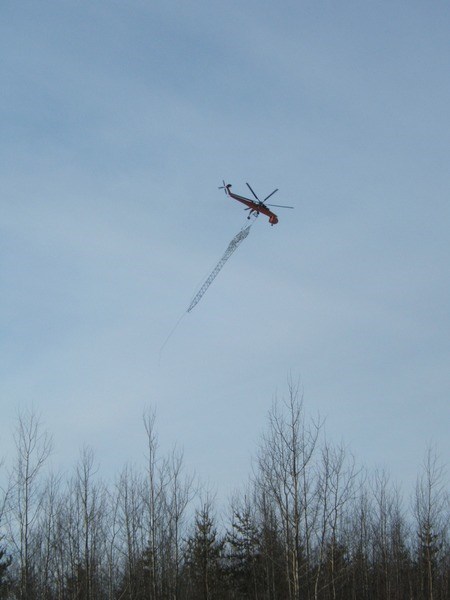Over the last several weeks, most folks around Snow Lake have seen a massive insect like helicopter buzzing around area skies. Those who haven't seen it have likely heard about the chopper that looks like a bug and moves hydro towers like they were toothpicks!
Whenever we see something uncommon in our skies, it is natural to wonder what it is, where it comes from, how it works, and why it's here? Logical questions and all in need of an answer. So in order to get responses to those queries, they were put to Hayley McNeil who is a health and safety advisor for Valard Construction, the contractor putting up area hydro towers in conjunction with the Wuskwatim Hydro Project.
Firstly, the chopper is a S-64E Aircrane helicopter, manufactured by the Erickson Air-Crane, and operated by Canadian Air-Crane of Delta, B.C. Erickson Air-Crane currently owns and operates a fleet of 17 S-64 Aircrane helicopters worldwide. The Aircrane is used primarily for aerial timber harvesting, fire suppression, and heavy construction.
The S-64 Aircrane is the only purpose-built flying crane in existence. Its unique design features an aft-facing (rear) pilot station, which allows the pilot full control of the air crane and an unobstructed view while placing loads within millimetre tolerances. The S-64 Aircrane has a crew of two pilots, a conventional forward facing pilot position and the aft facing pilot position. The forward facing pilot flies the aircraft to and from the work site. The aft facing pilot operates a full set of flight controls to manoeuvre the aircraft during load hook up and load placement. A Plexiglass bubble air shield offers the aft facing pilot an unobstructed view of the load being carried by the helicopter.
Components such as the innovative anti-rotation rigging system, hydraulic grapple, high volume fixed firefighting tank, and 30-second snorkel refill system enhance the Aircrane's ability to perform effectively within the spectrum of civil protection. As a worldwide family of companies, Erickson Air-Crane has flown nearly 250,000 hours over 35 years, harvested timber in five countries, battled fires in 11 countries, placed over 40,000 air units on skyscrapers across the United States, and built over 8,000 miles or 13,040 kilometres of power line in North America.
Erickson Air-Crane was originally formed in 1971 with the purchase of four of the first commercially available Sikorsky S-64 Skycranes. These aircraft were used primarily for logging operations in the Northwestern United States. However, because of the precision installation capability offered by the Skycrane, it was not long before other unique duties for the "Flying Crane" were discovered. Almost immediately, professional transmission tower installation work proved successful with the Skycrane. The first transmission tower set by Erickson Air-Crane was for Pacific Gas & Electric Company in 1971. Since that time, Erickson has erected more than 8,000 miles of transmission lines. In 1992, Erickson purchased the type certificate from Sikorsky and the designation changed from 'Skycrane' to 'Aircrane'.
The Aircrane's local crew consisted of pilots Max Evans, Travis Harold, and Fran Tebbe. All flew from each of the three pilots stations. Crew chief Adam Warner was responsible for all maintenance to the aircraft and all ground support equipment. Jason Weber was the project manager for the overall job between Erickson and Valard.
Though it was obvious that the Aircrane was placing towers while in the area, it is quite a bit more complicated than that. The towers that they were placing were 230KV guide Y transmission towers that Valard preassembled the previous summer. Watching the activity, they seemed to pickup and place them at timely intervals and it was noted that Erickson would take anywhere from five minutes to 15 minutes a structure, depending on the distance to set these structures and return with another.
In order to place the towers, the aircraft would hover over a structure that was laid on its side in the fly yard, attach four electric hooks to the load, and stand it up. Once the load was up and stable, the pilots would fly it out to the right of way, where a radioman would call the loads in and be a second set of eyes on the ground for the pilots. The pilots and ground crews would work together to set the structure on a 1 x 6-inch long pin that would go through a 1- 5/8 hole in the structure. After the pin was set, the pilots would lean the structure to one side to allow the ground crew to attach two guy wires. Then they would stand the structure up and pull tension on those two fixed wires, while the ground crew would run to the other side of the structure and attach two more guy wires (using jacks to pull the wire tight), then finally attach the structure permanently. After the structure was secure, the pilots would release the load and go back for another. This particular job had three different types of structures to set.
To help in this process, Erickson Air-Crane has developed a load orientation device and guide system for use in erecting transmission towers. The anti-rotation rigging provides four cables for lifting and prevents the load from rotating independently of the helicopter. This gives the aft facing pilot complete control over the load being carried. The guide system consists of fixed guides and stops that assist in aligning the tower sections and securely holding the sections when they are bolted together after the helicopter has placed the section and departed. The guide system is adaptable to virtually all transmission tower structures.
Valard's work in the area has been ongoing over the past two winters; however, McNeil advises that all the foundations and footing are installed, all towers on the line are mounted, and there is approximately 25 miles of conductor left to string from Hwy 39 to the Herblet Substation.
Work is expected to be completed by the end of March.




